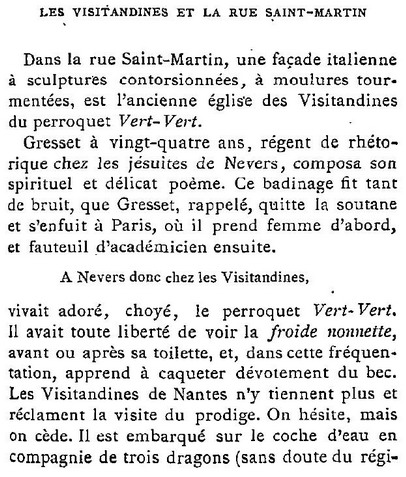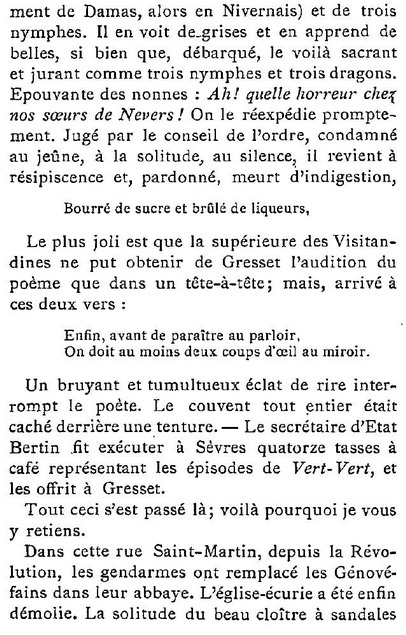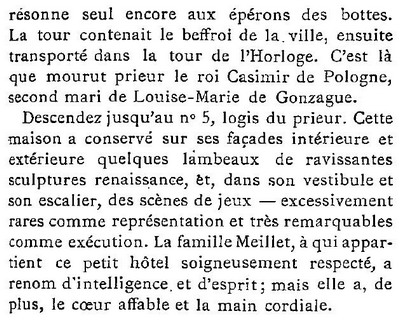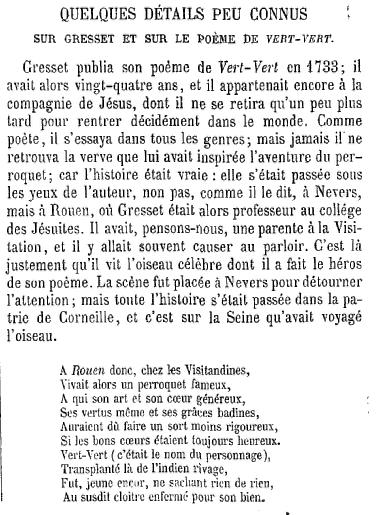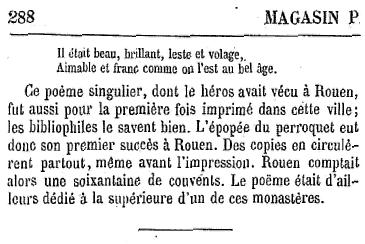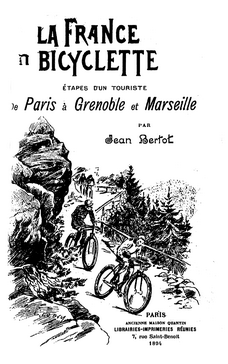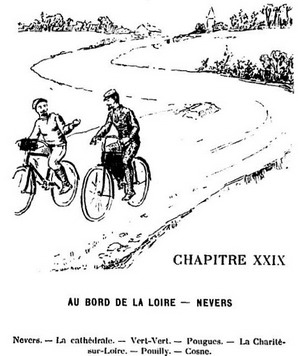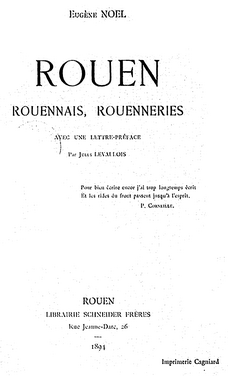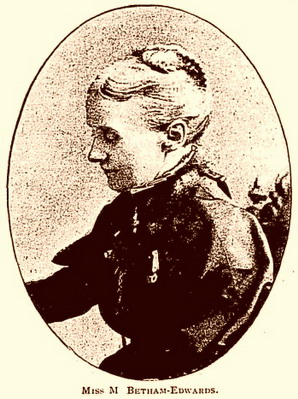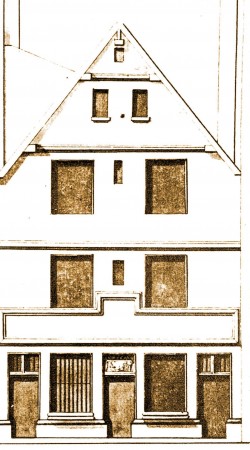

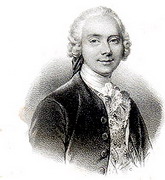
|
Inhoud
HPM
|
|
1881. Janicot, J. (Dr). Des Maladies que guérissent ou améliorent les eaux de Pougues... et de la cure thermale à Pougues, par le Dr J. Janicot,.... |
Janicots boek gaat over de geneeskrachtige
bronnen in het kuuroord Pougues, nabij Nevers. Maar een uitstapje
naar de stad is uiteraard ook bevorderlijk voor de gezondheid...
|
Source: Gallica |
|
Bericht uit het tijdschrift Le Livre Anoniem |
Ver-Vert bestond echt, maar niet in Nevers
Le poème de Vert-Vert: — Lorsque Gresset publia son poème de Vert-Vert en 1733, il avait vingt-quaire ans et appartenait encore à la compagnie de Jésus, dont il ne se retira que plus tard pour rentrer décidément dans le monde. Comme poète, il s'essaya dans tous les genres, mais jamais il ne retrouva la verve gauloise que lui avait soufflée l'aventure du perroquet; car l'histoire était vraie : elle s'était passée sous les yeux de l'auteur, non à Nevers, mais à Rouen, où Gresset était alors professeur au collège des Jésuites. Il avait, paraît-il, une parente à la Visitation, et il y allait souvent causer au parloir. C'est là qu'il vit l'oiseau célèbre. La scène fut placée à Nevers pour détourner l'attention, mais c'est à Rouen que toute l'histoire s'était passée et c'est sur la Seine et non sur la Loire qu'avait voyagé Vert-Vert.
L'épopée du perroquet est donc son premier succès à Rouen, où elle fut imprimée d'abord. Des copies en circulèrent partout, même avant l'impression, et firent la joie et la récréation d'une soixantaine de couvents que Rouen possédait alors. Le poème était d'ailleurs dédié à la supérieure d'un de ces monastères. Ce qui prouve surabondamment que Vert-Vert était un perroquet normand.
Dit bericht lijkt gebaseerd op een artikel dat in 1879 verscheen in Le Magasin Pittoresque:
|
|
|
Auteur onbekend Une tournée du Conseil de Révision
|
LES VISITANDINES DE LA RUE SAINT-MA RTINVert-Vert Dans la rue Saint-Martin, voici l'ancienne chapelle du couvent de la Visitation. La façade est italienne, à sculptures contorsionnées, à moulures tourmentées ; elle date du dix-septième siècle, en style de la plus pure Renaissance. C'est là que fut élevé Vert-Vert, le fameux perroquet dont Gresset, à vingt-quatre ans, régent de rhétorique chez les Jésuites do Nevers, raconta les aventures dans un poème spirituel et délicat. Ce badinage fit tant de bruit que Gresset, rappelé, quitta la soutane et s'enfuit à Paris, où il se maria et devint académicien. À Nevers donc, chez les Visitandines, vivait adoré, choyé, le perroquet Vert-Vert :
Le plus joli est que la mère supérieure des Visitandines ne put obtenir de Gresset l'audition du poème que dans un tête à-tête ; mais, arrivé à ce passage ; Enfin, avant de paraître au parloir,On doit au moins deux coups d’oeil au miroir ; un bruyant et tumultueux éclat de rire interrompit le poête. Le couvent tout entier était caché derrière une tenture. Bertin, alors secrétaire d'Etat, fit exécuter à Sèvres quatorze tasses à café représentant les épisodes de Vert- Vert, et les offrit à Gresset. Vert-Vert fut soigneusement empaillé; nous avons eu l'occasion de le considérer, il y a quelques années, chez Mme Manuel, boulevard Victor-Hugo, á Nevers. Il a été acquis, à la suite de la vente du mobilier de cette dame décédée, par un de nos amis, M. S..., chez qui on peut le voir. En 185..., le couvent des Visitandines a été transféré de la rue Saint-Martin à la route de Paris, dans un vaste établissement construit par les soins de M. Dufêtre, alors évèque de Nevers. |
|
|
Bertot, Jean (1856-19..). La France en bicyclette : étapes d'un touriste : de Paris à Grenoble et à Marseille....
|
Ver-Vert onbekend in Nevers
Mais le joyau de Nevers, plus austère, et plus intéressant que sa cathédrale, c'est l'église Saint-Etienne. Tout entière du style romain auvergnat, ancienne chapelle d'un monastère de Bénédictins, elle possède une unité de style bien rare. Toutes ses chapelles formant absides à l'extérieur, ses arcades en plein cintre et ses étroites fenêtres en font un type remarquable. Le beffroi, hautain et carré, de belles maisons en bois, l’évêché, un véritable palais du temps de Louis XIV, attirent encore notre attention. Nous voudrions savoir, par-dessus tout, s'il y a encore un couvent de Visitandines :
Mais tous les indigènes que nous interrogeons à ce sujet ne comprennent rien à notre histoire de perroquets et de religieuses, et se figurent que nous nous moquons d'eux. II n'y a pas de ville en France où Vert-Vert soit moins connu qu'à Nevers. |
|
|
1894 Noël, Eugène (1816-1899). Rouen. Rouennals. rouenneries.
|
A Rouen donc... Sur la continuation de la rue Grand-Pont, rue Beau-voisine, est un ancien couvent de Visitandines. L'aimable poète Gresset, qui habita Rouen quelque temps, eut dans ce couvent des relations d'amitié et, je crois, de parenté. Là, ne vous en déplaise, vécut et mourut le perroquet Vert-Vert, car c'est à Rouen et non pas à Nevcrs que se passa l'aventure ;
On a retrouvé, il y a vingt ans, les cercueils de quelques-unes de leurs supérieures : cercueils capitonnés d'un satin doux, fin et moelleux..... Voilà qui montre jusqu'où étaient portés…
Le côté anecdotique ne tarit pas plus ici que le grand côté historique. |
|
|
1900 - ca.
JEAN BUGAREL :
HISTOIRE du LYCÉE de NEVERS. RECHERCHES, ÉTUDES, DOCUMENTS DE 1900 À
1908 |
De kamer van Ver-Vert in Nevers in
ere gehouden L’Administration occupait le corps de bâtiment le plus noble, entre la cour des grands et la cour d’honneur. L’appartement du Proviseur comprenait en annexe, une grande chambre isolée du reste de l’appartement et donnant sur la cour des grands. On appelait cette chambre « Ver-Vert » car on ne voulait point douter qu’elle avait été jadis occupée par le jeune professeur, Louis Gresset, au temps où le collège des Jésuites prospérait en ces lieux. En souvenir du spirituel et charmant poète, cette chambre était traditionnellement « décorée de rideaux de cretonne ornés de perroquets verts ». |
Voor de hele tekst, ga naar:
http://museduc.nevers.pagesperso-orange.fr/1900_1908.pdf Met dank aan Jos Swiers |
|
1900 ca. Prentbriefkaart / Carte Postale Het klooster in Nantes / Couvent des visitandines à Nantes |
|
Met dank aan Jos Swiers |
|
1907 Matilda Betham-Edwards Literary Rambles in France Chapter 18: Amiens and Vert-Vert Contributed by Jos Swiers |
AMIENS AND 'VERT-VERT'
During the heat wave of the present year (August 1906) I betook myself with a friend to the capital of the Somme, not bent upon again revelling in its treasures, revisiting its matchless cathedral with Ruskin for guide, not minded even to stroll through its magnificent museums, historic collections, and art schools. My errand was to visit the tomb of its one, its unique poet. For Vert-Vert stands absolutely alone in French literature. Nothing like it, or approaching to it, is to be found throughout the successive stages of that vast treasure-house. The history of the parrot, every line of which produces our unreluctant smile, has secured for its author an imperishable niche in the national Valhalla, and, for the bustling, prosperous, industrial city of his birth and residence, poetic lustre. That quiet, shady hotel garden was not to be quitted last August during the day, but as the sun declined we exchanged its comparative refreshingness and shadow for the cathedral. Here all was greyness and a temperature requiring discarded wraps. The tropical climate of the streets was left completely behind! Only two or three worshippers knelt here and there in the vast space; but, as is always the case, a priest with breviary in hand slowly paced backwards and forwards, keeping, I presume, an eye upon intruders. When I ventured to ask him the local of Gresset's tomb, to my surprise he replied in very good English. 'Yonder,' he said with an affable smile as he pointed to a tablet on one of the side pillars, 'is the monument; the Latin inscription is short, but very'—hesitating, he finished with a French word—'very spirituel.' 'Very witty,' I added, giving the first synonym that entered my head. 'Elegant,' I think, were the better word. The inscription is to the effect that Gresset, a son of Amiens and splendid follower of the Muses, born in 1709, died on the 16th June 1777, was interred elsewhere, and re-interred here on the 16th of August 1811. A verse from the 118th Psalm followed the figures. Poor Gresset! How happy would he have been could he have known that his memory would be thus gloriously perpetuated, generation after generation of the devout having this tribute before their eyes, the commemorative tablet forming part of the cathedral itself! And of perverse necessity the poet would have prided himself more on the monument than the works to which he owed it. Like Pascal, Gresset could not overcome the dogmatic teachings of early youth. In his later years he repudiated all claims to literary fame. His story shows how persistently and how remorselessly theological narrowness here waged war against intellectual originality. There is not a line in Vert-Vert, nor even in the little jeu d'esprit, Le Lutrin Vivant (The Live Lectern), that can be twisted into real disrespect to religion or the Church. But unfortunately Gresset had exercised wit and pleasantry in dealing with ecclesiastical objects and formulas, and but for tardy recantation he would doubtless have died under clerical ban. When only twenty-four, Jean Baptiste Louis Gresset, at that time a student of the Jesuit College of Louis le Grand, Paris, composed Vert-Vert. The poem, handed about in manuscript, took the public by storm; the clerical world was scandalised, and the young author was sent in disgrace to the Jesuit College of La Flèche in the Sarthe. Soon after, he threw up alike theology and seminarist's garb, cast in his lot with letters, established himself in Paris, and wrote play after play, a series of successes culminating in that of Le Méchant, a piece that to this day holds its own in the repertory of the Comédie Française. Gresset, then in the prime of life, returned to Amiens in 1749, there, with the royal permission, founding a literary academy. Unfortunately for his peace of mind, he was of a vacillating nature, and falling under the influence of Lamotte, Bishop of Amiens, was induced to burn all his unpublished manuscripts, and publicly repudiate his entire works. But the bishop's action only damaged himself and his unfortunate pupil. Gresset died a morbid, deluded, self-deluding devotee. Vert-Vert will delight the world as long as the tongue survives in which it is penned. Did leisure permit, and did the task look at all feasible, how delightful were it to translate into English the serio-comic story of the immortal parrot who travelled from Nevers to Nantes, falling into bad company on the way, and, as will happen to mortals, thereby losing all the good habits acquired in early youth. Vert-Vert, then, was a parrot, young, splendid to behold, vivacious, and the most insatiable picker-up of unconsidered trifles; in other words, imitating every syllable that fell upon his ears. But as he was the cherished darling of a convent, that of the Visitandines, he could of course learn only what was good and seemly; hence his reputation. Indeed, so far did his fame spread that the abbess of a sister-convent at Nantes insisted upon having a visit from him. So, amid tears and kisses of his friends, and heaps of bonbons being supplied for his journey, Vert-Vert was put on board a barge bound for the city on the Loire, among the passengers being three dragoons, two Gascons, with others not likely to be choice in their topics or words. So, when poor Vert-Vert reached his destination, what was the horror of the pious sisters when, instead of deferentially repeating the Benedicite, the Oremus, and canticles, he broke forth into terrible oaths and expletives never before profaning such walls. The novices, as they well might, thought the bird was speaking Greek! Bundled back to Nevers with a flea in his ear, Vert-Vert underwent a term of seclusion and bread and water, and when it came to an end, overjoy and an overdose of sugar-plums causing his death, all his faults were straightway forgiven. He was buried with every mark of grief, and an epitaph was composed by the nuns, ending thus--
|
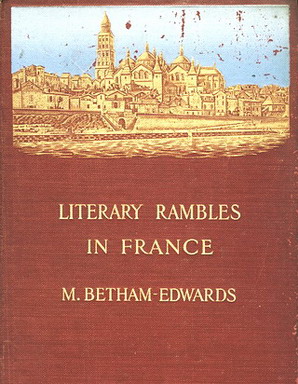 Matilda Betham-Edward's book is available on line at Archive.com. A fully edited transcription is available at: http://gerald-massey.org.uk/betham-edwards/index.htm
|
|
2006 De Groene Gids van Michelin en Lannoo over Nevers Bijdrage van Jos Swiers |
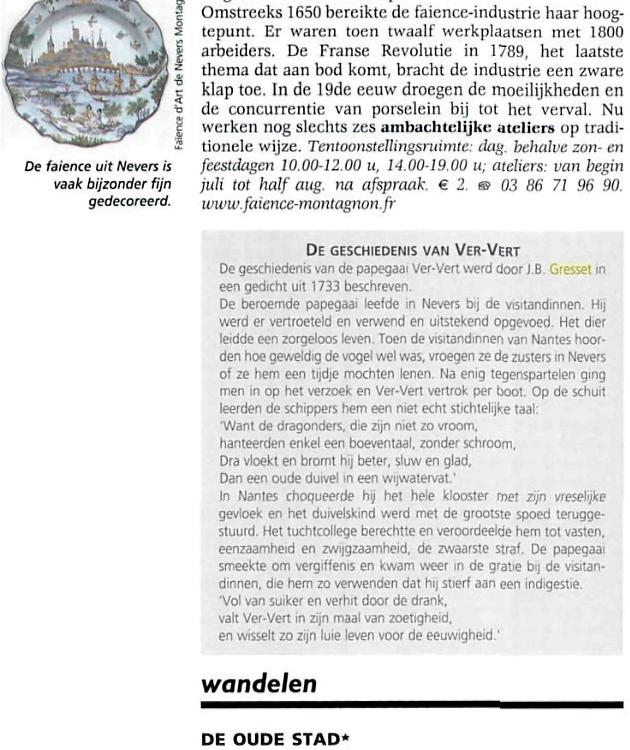 |
Screenshot from Google Books |
| 2013 |
Waar Gresset woonde in Parijs Maison de Nicholas Flamel et de dame Pernelle, avant les multiples transformations rue de Montmorency
Nous pouvons remarquer aujourd'hui que le pignon a disparu N° 12 : maison de Mme de Sévigné (avant l’hôtel Carnavalet) N° 11 : domicile du poète Gresset (« Vert Vert ») N° 5 : ancien hôtel de Montmorency, où mourut Théophile de Viau.Casanova y séjourna en 1763 |
|
|
|
||
